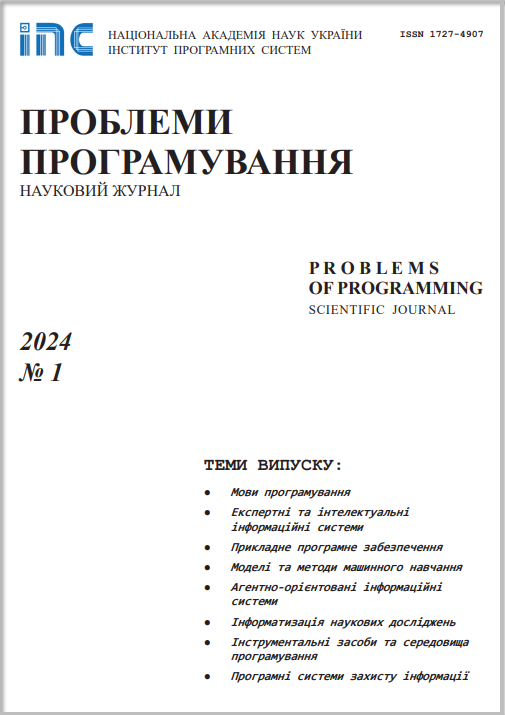Algebraic approach to the analysis of legal documents
Abstract
In this study, problems regarding the analysis of law articles and their conformance to legal documents are considered. The algebraic approach is used for the formal verification of legal texts that is presented as specification of behavior algebra. Having a formal presentation of legal texts allows for the application of algebraic methods, such as symbolic modeling, automatic proving of statements and algebraic matching. The approach was implemented for Ukrainian-language legal documents to detect inconsistency, incompleteness, and prove conformance. The analysis of legal texts has been implemented for Tax code and examples of inconsistency of some statements were demonstrated in the paper. Another experiment has been performed for checking of conformance of court statements, agreements, licenses, new laws, taxation acts to the articles of law with usage of methods of algebraic matching. The formalization of legal documents, like court verdicts, shall be implemented fully automatically, and the existing database with such documents shall provide the possibility to use big data technologies and machine learning. In this study, we consider the use of the algebraic approach in the analysis of legal requirements and law artifacts within the scope of the Insertion Modeling System (IMS). The subject of this research is the laws created by the legislature and the artifacts of legal activity, such as lawsuit decisions, agreements, licenses, and juridical cases. The problem to be considered is the analysis of legal documents for conformance with the law and the analysis of the law’s articles, checking for inconsisten- cies, incompleteness, and other interested properties. In this paper, we consider every element of the technology in detail, and we describe the methods and results of the experiments.
Prombles in programming 2022; 3-4: 117-127
Keywords
Full Text:
PDFReferences
LETICHEVSKY, A., LETYCHEVSKYI, O., & PESCHANENKO, V. (2016). Insertion modeling and its applications. Computer Science Journal of Moldova, 72(3), 357-370.
WASS, C., DINI, P., EISER, T., HEISTRACHER, T., LAMPOLTSHAMMER, T. J., MARCON, G., ... & WINKELS, R. (2013). OpenLaws. eu. In Proceedings of the 16th international legal informatics symposium IRIS (Vol. 292, pp. 21-23).
PEYCHEV, V. (2005). Legal document-a formal model. Problems of Engineering Cybernetics and Robotics, 55, 64-70.
PETERSEN, K. E. (2011). Experiences with "Lex Dania Live". In From Information to Knowledge (pp. 69-76). IOS Press. CrossRef
DRIZA MAURER ARDITA, HOLENSTEIN URS PAUL, 2006. The electronic publication of Swiss legislative acts. Development of a structured model for federal, cantonal and communal legal texts: the XML-CHLexML schema, In: Bundesamt für Justiz, Mitarbeiterinnen und Mitarbeiter; Schindler, Benjamin. Helbing Lichtenhahn, 391-401.
KAMAL, A., QURESHI, N., TARIQ, M., & CANTT, R. Optimal and Economic Solution for eLaw Data Storage and Retrieval.
FRANCESCONI, E. (2011). A review of systems and projects: Management of legislative resources. Legislative XML for the semantic Web, 173-188. CrossRef
BOER, A., HOEKSTRA, R., WINKELS, R., VAN ENGERS, T., & WILLAERT, F. (2002). Metalex: Legislation in xml. Legal Knowledge and Information Systems (Jurix 2002), 1-10.
ENGERS, T. V., BOER, A., BREUKER, J., VALENTE, A., & WINKELS, R. (2008). Ontologies in the legal domain. In Digital Government (pp. 233-261). Springer, Boston, MA. CrossRef
BREUKERS, J. A. P. J., & HOEKSTRA, R. J. (2004). Epistemology and ontology in core ontologies: FOLaw and LRI-Core, two. In Proceedings of EKAW Workshop on Core ontologies [Internet]. Northamptonshire, UK: Sun SITE Central Europe.
GANGEMI, A., PRISCO, A., SAGRI, M. T., STEVE, G., & TISCORNIA, D. (2003, November). Some ontological tools to support legal regulatory compliance, with a case study. In OTM Confederated International Conferences" On the Move to Meaningful Internet Sys- tems" (pp. 607-620). Springer, Berlin, Heidelberg.CrossRef
HOEKSTRA, R., BREUKER, J., DI BELLO, M., & BOER, A. (2007). The LKIF Core Ontology of Basic Legal Concepts. LOAIT, 321, 43-63.
GRIFFO, C. (2015). Ufo-l: A core ontology of legal concepts built from a legal relations perspective. Doctoral Consortium Contributions, IC3K-KEOD.
CASANOVAS, P., PALMIRANI, M., PERONI, S., VAN ENGERS, T., & VITALI, F. (2016). Semantic web for the legal domain: the next step. Semantic Web, 7(3), 213-227. CrossRef
SIRIN, E., PARSIA, B., GRAU, B. C., KALYANPUR, A., & KATZ, Y. (2007). Pellet: A practical owl-dl reasoner. Journal of Web Seman- tics, 5(2), 51-53. CrossRef
HORROCKS, I., PATEL-SCHNEIDER, P. F., BOLEY, H., TABET, S., GROSOF, B., & DEAN, M. (2004). SWRL: A semantic web rule language combining OWL and RuleML. W3C Member submission, 21(79), 1-31. https://www.w3.org/Submission/SWRL/
CABOT, J., CLARIS, R., & RIERA, D. (2008, April). Verification of UML/OCL class diagrams using constraint programming. In 2008 IEEE Inter- national Conference on Software Testing Verification and Validation Workshop (pp. 73-80). IEEE. CrossRef
ALI, S., BRIAND, L. C., ARCURI, A., & WALAWEGE, S. (2011, October). An industrial application of robustness testing using aspect-oriented modeling, UML/MARTE, and search algorithms. In International Conference on Model Driven Engineering Languages and Systems (pp. 108-122). Springer, Berlin, Heidelberg.CrossRef
MCCARTY, L. T. (1989, May). A language for legal discourse i. basic features. In Proceedings of the 2nd international conference on Artificial intelligence and law (pp. 180-189). CrossRef
SUTHERLAND, H., & FIGARI, F. (2013). EUROMOD: the European Union tax-benefit microsimulation model. International journal of microsimulation, 6(1), 4-26. CrossRef
Taylor, R., Sutherland, H., & Gomulka, J. (2001). Using POLIMOD to evaluate alternative methods of expenditure imputation. Mi- crosimulation unit research note MU/RN38.
POPPLE, J. (1996). A pragmatic legal expert system. Dartmouth (Ashgate). CrossRef
LETICHEVSKY, A. A., & GILBERT, D. (1998). A general theory of action languages. CrossRef
LETICHEVSKY, A., & GILBERT, D. (1999). Interaction of agents and environments. Resent trends in Algebraic Development technique, LNCS 1827, 272.
ITU-T, Z. 151 User requirements notation (URN)-Language definition. ITU-T, Nov, 2008, https://www.itu.int/rec/dologin_pub. asp?lang=e&id=T-REC-Z.151-201810-I!!PDF-E&type=items
LETICHEVSKY, A., LETYCHEVSKYI, O., PESCHANENKO, V., & POLTORACKIJ, M. (2017, September). An Algebraic Approach for Analyzing of Legal Requirements. In 2017 IEEE 25th International Requirements Engineering Conference Workshops (REW) (pp. 209-212). IEEE.CrossRef
Tax Code of Ukraine, https://zakon.rada.gov.ua/laws/show/2755-17?lang=en#Text
DOI: https://doi.org/10.15407/pp2022.03-04.117
Refbacks
- There are currently no refbacks.


